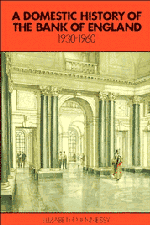Book contents
- Frontmatter
- Contents
- List of illustrations
- Foreword
- Acknowledgements
- Introduction
- 1 The Bank at war
- 2 The Accountant's Department
- 3 Exchange Control, 1939–1957
- 4 The note issue
- 5 The Printing Works
- 6 The Banking Department and the profitability of the Bank
- 7 The Cashier's Department
- 8 The Branches
- 9 Overseas, Economics and Statistics
- 10 The Establishment Department
- 11 The Secretary's Department
- Appendix Governors, Deputy Governors, Directors and Senior Officials, 1930–1960
- Notes
- Index
- Plate section
9 - Overseas, Economics and Statistics
Published online by Cambridge University Press: 05 March 2012
- Frontmatter
- Contents
- List of illustrations
- Foreword
- Acknowledgements
- Introduction
- 1 The Bank at war
- 2 The Accountant's Department
- 3 Exchange Control, 1939–1957
- 4 The note issue
- 5 The Printing Works
- 6 The Banking Department and the profitability of the Bank
- 7 The Cashier's Department
- 8 The Branches
- 9 Overseas, Economics and Statistics
- 10 The Establishment Department
- 11 The Secretary's Department
- Appendix Governors, Deputy Governors, Directors and Senior Officials, 1930–1960
- Notes
- Index
- Plate section
Summary
It was not until 1927 that the Bank's inter-war preoccupation (stemming largely from Governor Norman's special interest in the topic) with the question of relationships between central banks was formalised by the establishment of the Central Banking Section within the Chief Cashier's Office. The Section had two main functions: to conduct the Bank's relations, both business and diplomatic, with other central banks, and to provide a ‘nursery’ in which selected members of the junior staff could be trained for the new responsibilities of a central bank. Professor Sayers has described in some detail the Bank's activities in the 1920s and 1930s to promote and foster central banking in the Commonwealth and elsewhere, by the provision of advice (including participation in many financial missions, sometimes together with representatives from the Treasury), help in drawing up statutes and, quite frequently, personnel. For example the Bank's Chief Accountant, W. H. Clegg, became Governor of the new South African Reserve Bank in 1920 and Leslie Lefeaux, an Assistant to the Governors and previously Deputy Chief Cashier, was appointed the first Governor of the Reserve Bank of New Zealand in 1934. This policy of what might be described as enlightened self-interest on the part of the Bank of England was one to which it adhered tenaciously: the desire to get the new banks established on the ‘right’, i.e. Bank-drawn lines, was combined with equally strong feelings about the importance of worldwide solidarity among central banks as a group whose centre of gravity was in London – and who were thus, inevitably, closely allied with sterling.
- Type
- Chapter
- Information
- A Domestic History of the Bank of England, 1930–1960 , pp. 293 - 323Publisher: Cambridge University PressPrint publication year: 1992



